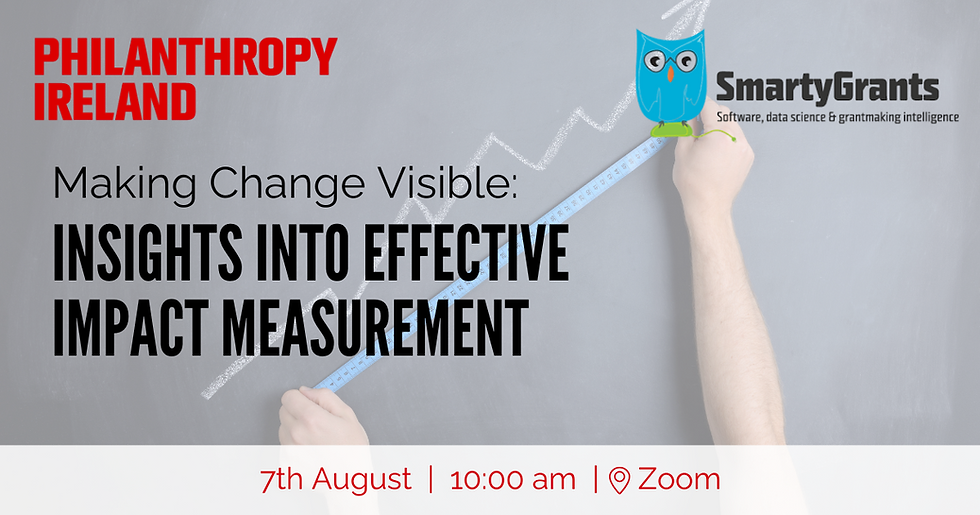Training Workshop on Impact Assessment
- May 2, 2023
- 3 min read
Updated: Jul 14
By: Hazel Hennessy, Philanthropy Ireland
Led by by philanthropy adviser, Emma Lane-Spollen in May 2022
Useful Materials & Resources
6 Key Learnings on Assessing Impact as a Funder
“If you don’t know where you are going, any road will get you there!” – Lewis Carroll
Are good intentions enough? How do we know we are making a difference?
A group of diverse philanthropy practitioners came together for a two-part session facilitated by Philanthropy Ireland (PI) to probe into these questions.
The two sessions led by philanthropy adviser, Emma Lane-Spollen, were held as part of PI’s ‘Philanthropy in Practice series’ in the first two weeks of May 2022. While the first session focused on assessing impact as a funder, the second session explored supporting grantees in assessing their impact.
As the landscape of philanthropy shifts its focus from outputs to outcomes, getting to impact has become an urgent and relevant need. Whilst inquiring into the many challenges in impact assessment, discussions with Emma Lane-Spollen helped us put together key learnings for a journey in impact practice.
1. There is a need to measure foundation level impact
The way impact is approached at a foundation level strongly influences practice. When a foundation goes beyond examining the impact of individual grants, it leads by example, reflects accountability and is able to walk-the-talk. Measuring foundation level impact can be beneficial on several counts. On the one hand it informs foundations if they are succeeding, and on the other hand it provides them with abundant scope for learning and improvement. The need to measure foundation level impact is also driven by the need to check if the funding is put to effective use and further develop a more strategic and structured giving.
2. There is no one single way
Impact is defined, perceived, and visualised by different stakeholders, differently. Defining what impact means to them should be the first and most essential step every funder takes as they begin their impact assessment journey. This exercise will determine the course of their funding and influence their impact practice – i.e., planning desired impact, planning how to measure it, collecting information about it, making sense of that information, communicating it, and learning from it.
3. Articulating social impact goals brings the much-needed clarity
A funder’s impact journey begins with articulating social impact goals. Identifying the goals involve defining the problem the foundation/funder seeks to address. Understanding the problem often suggests the approaches that might bring beneficial change. This in-turn brings the much-needed clarity and helps chart a course of action that optimises impact for all parties involved.
4. Measuring what matters helps determine impact
Once the impact goals are defined and the focus is on outcomes rather than the outputs, the pertinent thing to do is to measure the indicators that are relevant to the outcomes in focus. In other words, measure only what matters. Additionally, it must be ensured that the time, effort, and methods applied in measuring these indicators are proportionate and appropriate to the scale and scope of the work. This way a small number of appropriate measures are evaluated which can in-turn help determine impact.
5. It is important to consider the full range of the difference made
Programs are largely evaluated for the course of funding and its impact is studied for a stipulated period. It must be observed that the programs might have a longer term and wider impact than anticipated. It is crucial to be conscious that programs might have an impact that could go beyond intended beneficiaries, which is either negative or positive. Therefore, it is important to take all the full range of changes into account and understand the extent of the same.
6. The funder-grantee relationship is vital in achieving impact
Funding relationships, including impact practice, should be based on mutual recognition of respective values, roles, and responsibilities. Flexibility, openness, and transparency will help build trust, foster ongoing dialogue, increase impact and ensure genuine learning about what works well and what does not.
In addition to the key learnings summarised above, the sessions drew from best practices and literature on impact practice. Both the sessions were hands on training experiences which enabled its participants to introspect, envision and reimagine what impact meant for them. Altogether, learnings from the sessions help address the burning question around impact assessment – Where do we begin?





Comments